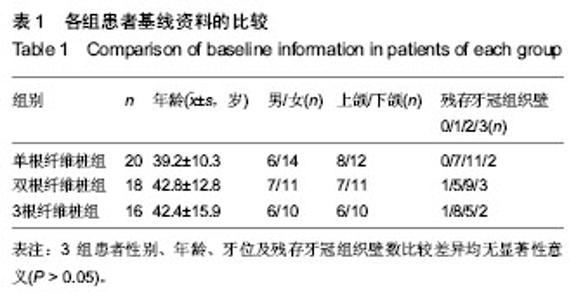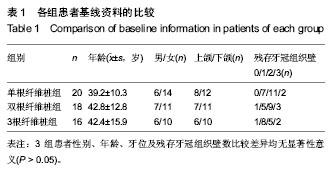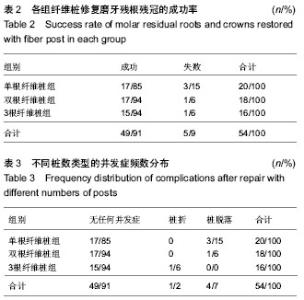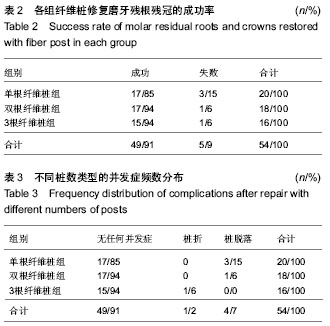| [1] 赵铱民.口腔修复学[M].6版.北京:人民卫生出版社,2008.
[2] Novais VR,Quagliatto PS,Bona AD,et al.Flexural modulus, flexural strength, and stiffnessof fiber-reinforced posts.Indian J Dent Res.2009;20:277-281.
[3] Lamichhane A,Xu C,Zhang F.Dental fiber-post resin base material: a review.J Adv Prosthodont.2014;6(1):60-65.
[4] Goodacre CJ.Carbon Fiber Posts may Have Fewer Failures Than Metal Posts.J Evid Base Dent Pract. 2010;10(1):32-34.
[5] Dikbas I,Tanalp J.An Overview of Clinical Studies on Fiber Post Systems. Scientific World Journal.2013;23:1-6.
[6] Bru E,Forner L,Llena C,et al.Fibre post behaviour prediction factors.A review of the literature.J Clin Exp Dent. 2013;5(3): e150-153.
[7] 周莉丽,王青.铸造金属桩与纤维桩临床疗效的比较[J].上海口腔医学,2012,21(6):709-713.
[8] 刘峰.纤维桩及其应用要点[J].中华口腔医学杂志,2011,46(7): 442-445.
[9] 刘玉华,孙樱林.多根管桩核技术的临床应用及力学分析[J].现代口腔医学杂志,2007,21(1):7-9.
[10] 付钢,杜莉,任嫒姝,等.不同设计桩核的后牙残根核桩冠修复体的三维有限元应力分析[J].华西口腔医学杂志,2009,27(1):24-28.
[11] Santos-Filho PC,Veríssimo C,Soares PV,et al.Influence of Ferrule,Post System,and Length on Biomechanical Behavior of Endodontically Treated Anterior Teeth.J Endod. 2014;40(1): 119-23.
[12] 俞灏,隋磊,胥春.后牙桩核修复设计研究进展[J].口腔颌面修复学杂志,2012,13(5):309-311.
[13] 刘新庆,刘怡珍,刘淑琴.多个玻璃纤维桩树脂核修复磨牙残冠[J].中国组织工程研究与临床康复,2011,15(38):7161-7164.
[14] 刘峰.纤维桩修复技术[M].北京:人民卫生出版社,2012.
[15] Jiangkongkho P, Kamonkhantiku K, Takahashi H, et al. Fracture resistance of endodontically treated teeth using fiber post with an elastic modulus similar to dentin. Dent Mater J, 2013;32(5):781-786.
[16] Bitter K, Noetzel J, Stamm O,et al. Randomized clinical trial comparing the effects of post placement on failure rate of postendodontic restorations: preliminary results of a mean period of 32 months. J Endod.2009;35:1477-1482.
[17] 刘畅,薛莉,张玉.纤维桩修复严重缺损后牙的临床疗效评价[J].国际口腔医学杂志,2013,40(1):24-27.
[18] 杰恩斯,史力,刘鹏,等.纤维桩核修复3种上切牙牙冠缺损类型的有限元应力对比[J].中国组织工程研究与临床康复, 2009, 13(17): 3251-3255.
[19] 毛莹莹,刘 淼,姚贵良,等.后牙纤维桩桩核冠修复的临床应用研究[J].中国美容医学,2014,23(3):234-236.
[20] Eraslan O,Aykent F,Yucel MT,et al.The finite element analysis of the effect of ferruleheight on stress distribution at post-and-core-restored all-ceramic anterior crowns.Clin Oral Investig.2009;13(2):223-227.
[21] 王家安,张新春.Tenax Fiber White玻璃纤维桩修复前牙残根残冠[J].中华口腔医学研究杂志:电子版,2012,6(1):57-64.
[22] Ferrari M,Vichi A,Fadda GM,et al. A randomized controlled trial of endodontically treated and restored premolars.J Dent Res.2012;91(7 Suppl):72S-78S.
[23] Sarkis-Onofre R,Jacinto Rde C,Boscato N,et al.Cast metal vs. glass fibre posts: A randomized controlled trial with up to 3 years of follow up.J Dent.2014;42(5):582-587.
[24] Naumann M,Preuss A,Rosentritt M.Effect of incomplete crown ferrules on load capacity of endodontically treated maxillary incisors restored with fiber posts,composite build-ups, and all-ceramic crowns: an in vitro evaluation after chewing simulation.Acta Odontol Scand.2006;64(1):31-36.
[25] Sorrentino R,Monticelli F,Goracci C,et al.Effect of post- retained composite restorations and amount of coronal residual structure on the fracture resistance of endodontically- treated teeth.Am J Dent.2007;20(4):269-274.
[26] Salameh Z,Sorrentino R,Papacchini F,et al.Fracture resistance and failure patterns of endodontically treated mandibular molars restored using resin composite with or without translucent glass fiber posts.J Endod.2006;32(8):752- 755.
[27] 索万奎.磨牙缺损桩核修复的临床探讨[J].口腔颌面修复学杂志, 2009,10(2):79-84.
[28] Hou QQ,Gao YM,Sun L. Influence of fiber posts on the fracture resistance of endodontically treated premolars with different dental defects.Int J Oral Sci.2013;5(3):167-171.
[29] Naumanna M,Blankensteina F,Dietrich T.Survival of glass fibre reinforced composite post restorations after 2 years-an observational clinical study.J Dent.2005;33:305-312.
[30] Ferrari M,Cagidiaco MC,Goracci C,et al.Long-term retrospective study of the clinical performance of fiber posts. Am J Dent.2007;20:287-291.
[31] Zicari F,Couthino E,De Munck J,et al.Bonding effectiveness and sealing ability of fiber-post bonding.Dent Mater.2008; 24(7):967-977.
[32] 高凯,张保卫.三种树脂水门汀与纤维桩粘接强度的研究[J].口腔颌面修复学杂志,2011,12(1):32-35. |



